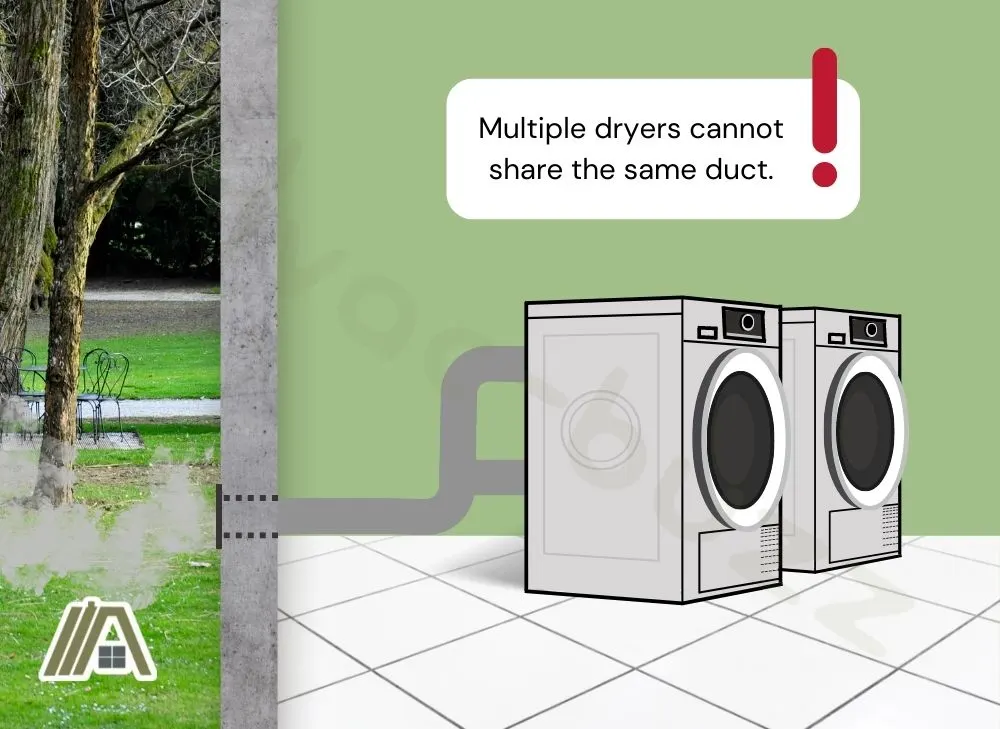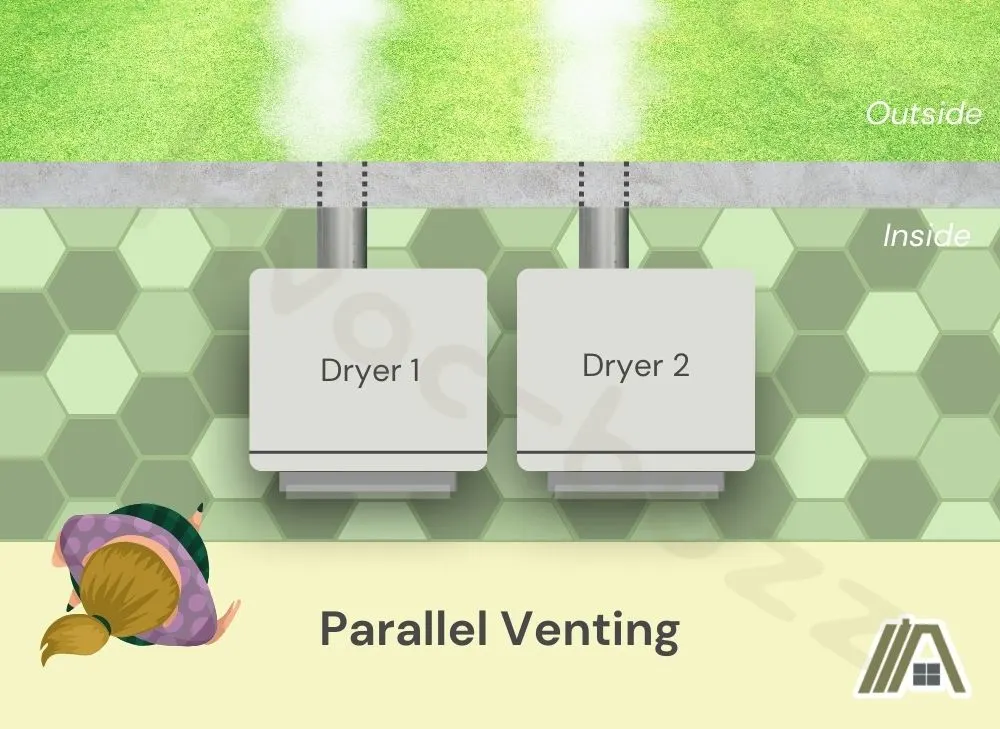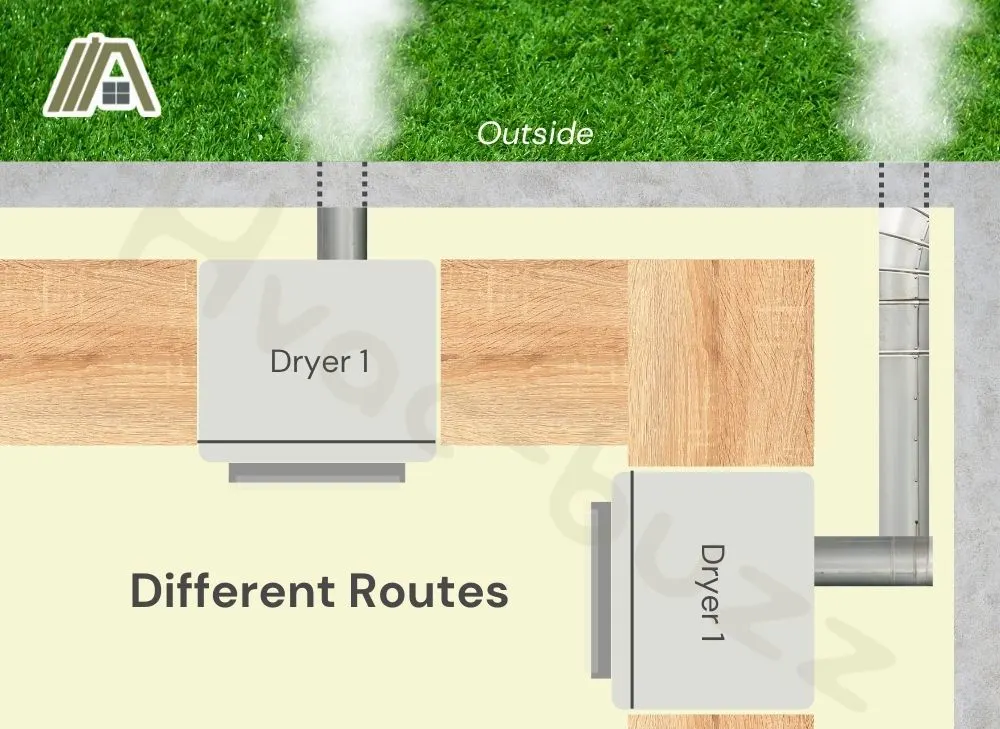Having multiple dryers in a house can increase the lifespan of the dryers, and it can also help ensure proper care of your clothing. With multiple dryers, you are able to split up larger loads, making it easier on your dryer. This also decreases the amount of time you have to spend doing laundry.
Before installation, however, it is important to decide how you want your dryer’s ventilation to run. Looking at and deciding the best duct installation can not only greatly improve your experience but also save you from potential danger and code violations.

Dryers cannot share vents. The separate ducts can run parallel or follow divergent paths. Each option has pros and cons. Another option is to have one vented and one ventless dryer, so only one ventilation system is required.
In accordance with International Residential Code (IRC), Section M1502.2:
“Dryer exhaust systems shall be independent of all other systems and shall convey the moisture to the outdoors.
Exception: This section shall not apply to listed and labeled condensing (ductless) clothes dryers.”
This means that dryer systems are legally required to be independent of each other (and any other exhaust system) and cannot share a duct. This, however, does not apply to certain electric dryers or heat-pump dryers that do not use ducts (ventless dryers).
Reasons for the Prohibition
The primary reason that multiple dryers cannot share the same duct is for safety.
For one, sharing a duct creates a fire hazard. When there are two dryers sharing a duct, the duct will accumulate double the amount of lint, which is highly flammable.

In addition, multiple dryers will increase the amount of hot air in the duct system. This means that hot air is not able to cool as efficiently as it should. If this is the case, the air that leaves the exhaust will be hotter, which can be dangerous.
Another danger introduced when putting multiple dryers on the same duct is the possibility of exhaust reentering the home. This is because there is another path for the exhaust to travel, which is into the other dryer.
There should be systems in place to prevent this (i.e., backdraft dampers), but these can fail.
Exhaust from a dryer is highly dangerous, as it contains compounds such as carbon monoxide and certain volatile organic compounds. Not only are they highly toxic, but they are often hard to detect. Therefore, it is important to prevent any risk of inhaling these compounds.
The moisture and heat released by dryers can also cause problems when these are released inside the house.
Parallel Venting
If you are looking for an easy way to vent multiple dryers, then you should consider parallel venting, which is where you run both vents next to each other on the same path.
Benefits
There is a multitude of benefits to running your vents parallel to each other. For one, you only have to plan and plot out one path, which is likely the shortest and most efficient path.
Oftentimes, it can be difficult to find an additional path if you are adding another duct system. Parallel venting gets rid of this problem entirely.
Another benefit is that you are able to access both ducting systems at the same time. Since they are next to each other, it is much faster and much easier to perform routine inspections. This also makes it easier to clean both ducts.
On the thought of cleaning, having both vents run parallel means that any lint will be blown out of the same area on the roof or wall. This means you only need to clean one area of lint rather than the two you’d have to clean if your vents had different routes.
In many cases, running the venting parallel means that you’ll be saving space. This is because both vents will likely be taking the shortest route and there is little room between vents, leaving more room for other appliances.

Drawbacks
Running your vents parallel is not without its drawbacks, however. In fact, it may be possible that parallel venting is not an option for your house. This can be because there is only enough room to run one duct its path.
It is possible to switch to smaller duct sizes, but this can, in turn, negatively impact the efficiency of the exhaust.
On the other hand, it is possible that you don’t have enough room for the dryers themselves. Since they have to sit in the same area, you may not have enough room to sit both dryers next to each other, making parallel vents not possible.
When you run multiple ducts next to each other, it is important to insulate them. This is to prevent the temperatures between multiple ducts from interacting. If you are considering running your ducts parallel, it could become a hassle to insulate them.
Having both termination vents next to each other can also increase the risk of failure and leaks because a larger percentage of a certain portion of the wall or roof will be compromised.
This means that you will likely have to do more repairs on your ventilation if you run them parallel rather than running them in different directions.
Different Routes
If parallel ventilation routes do not fit your style or your space, an alternative would be to have your dryers take different pathways to the outdoors.
Benefits
There are a couple of benefits if you decide to route your dryer ducts differently.
Firstly, each route will only need enough space to fit one duct. This can be extremely beneficial if there are only a few spots that can run more than one duct if any.
In addition, you will not have to sacrifice duct size when installing multiple dryers. In fact, you can often times have larger ducts. Larger ducts mean improved airflow efficiency which can be beneficial for the entire dryer system.
You also have more freedom for where you want to install your extra dryers. For instance, you can install both dryers next to each other. But, if you don’t have the extra room or if you want to place the dryer in another location, you can do so easily.

Since the ducts would take separate paths, you are able to vent them out in different spots, which limits the risk of installation failure and leaks. This is because the spots that you vent them out are less compromised than the singular ventilation spot if you were to run the vents parallel.
On top of that, you don’t need to go through the hassle of insulating the entirety of both ducts. Instead, you’ll only need to insulate the areas where they travel through unconditioned space.
Drawbacks
As with running your vents parallel, running your vents on different paths also has its own drawbacks.
For one, you will have to plot out two different paths. While it can be simple in some cases, in others plotting out a different path can become frustrating, especially if there are a lot of obstacles.
This can lead to one path being much longer than the other, which is something you want to avoid as a shorter path means a more efficient ventilation system.
Another hassle is that two routes mean you have to access each duct separately. This can make it much more annoying to perform routine dust inspections and cleanings.
In line with cleaning, because each duct has a different exit point, lint is released in two or more areas outside the home. This means that you will have to clean multiple spots on the roof or near a wall, which can become a hassle as well.
Alternative: One Ventless Dryer
If neither parallel venting nor venting with different routes sounds appealing, or if you are looking for an easier and less invasive way to install another dryer, you could opt for a ventless dryer.
An example of a ventless dryer is a heat pump dryer, which uses a combination of heating and cooling mechanisms to dry clothes without requiring ventilation.
If you live in the US, it may be more expensive and more difficult to buy a ventless dryer compared to if you live in Europe. This is because they are not as common as vented dryers, as homes in the US often have the space for vented dryers.
This is not to say that a ventless dryer is not a good investment, however, since they can often cost less to operate and they are a much more eco-friendly alternative to a vented dryer.
